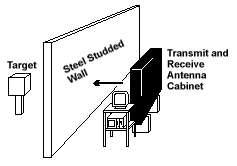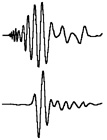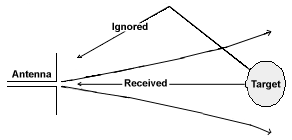Patriot Scientific Corporation has developed
radar technologies with a wide range of possible applications.
This description below will highlight possibilities for use in:
- Ground Penetrating Radar (GPR)
- Communications
- Surveillance
- Ordinance Detection
- Stealth Radar
The Demonstration System
 This
is a diagram of the demonstration system. A pulse generator is
used to drive the transmit antenna. The pulse is a positive spike
going up to 100V then falling back to ground in one and a half
nanoseconds corresponding to a pulse transmit frequency of 750
MHz.
This
is a diagram of the demonstration system. A pulse generator is
used to drive the transmit antenna. The pulse is a positive spike
going up to 100V then falling back to ground in one and a half
nanoseconds corresponding to a pulse transmit frequency of 750
MHz.
The return signal is read by the receive antenna.
At this point some simple analog processing is done and the signal
is digitized at a resolution of 6 GHz, and sent to a PC.
The PC correlates the data into a conventional
waveform, does some processing, then transmits the data over
an ethernet cable to a Pentium workstation (not shown).
The Pentium workstation is used to apply different
digital filters, combine waveforms, and display the results.
This system can be used to demonstrate detection of small targets
buried in sand, people behind walls, and other targets.
 Patriot
has used its antenna system to demonstrate detection of objects
as small as a coke can buried in sand, through a wall. Even small
targets disturb the wavefront of the pulse, producing reflections
and modifing the field in measurable ways.
Patriot
has used its antenna system to demonstrate detection of objects
as small as a coke can buried in sand, through a wall. Even small
targets disturb the wavefront of the pulse, producing reflections
and modifing the field in measurable ways.
Patriot will be testing this technology for
suitability for mine detection. We will be acquiring sample casings
and running further tests.
Advantages of Patriot's Impulse Radar System
 The
key to Patriot's Radar system is its ability to transmit and
receive pulses barely longer then single cycles at the transmit
frequency. The first waveform shown here is a pulse generated
by an earlier Patriot Design, based on "off the shelf"
antenna technology. The waveform on the bottom was produced and
received by Patriot's current Design.
The
key to Patriot's Radar system is its ability to transmit and
receive pulses barely longer then single cycles at the transmit
frequency. The first waveform shown here is a pulse generated
by an earlier Patriot Design, based on "off the shelf"
antenna technology. The waveform on the bottom was produced and
received by Patriot's current Design.
The current Patriot antenna system produces
a pulse at the desired frequency with little leading or trailing
noise. The Patriot antenna system provides many advantages over
pulse-based systems.
Patriot originally developed the impulse radar
system to allow time domain processing in Patriot's GPR systems.
Because the impulse is extremely short (3 nanoseconds), the time
to return can be used to gauge the distance traveled by the pulse.
Furthermore, the transmit and receive antenna's are very directional,
eliminating much of the multipath components of the return signal.
The short pulse combined with the directional transmit and receive
to provide us with a number of important advantages:
- Very low average power during transmission
- Low interference from other transmitters
- Transmission invisible to conventional receivers
- High bandwidth digital data transmission
possible
- Difficult detection by other impulse receivers
 Interference
with other sources and receivers is further reduced by using
directional antennas. The antenna design shown is highly directional.
When penetrating the ground, we wish to eliminate as much of
the multipath signal as possible. The directional antennas reduce
the multipath signals detected to those that are relatively inline
with the wave path, and eliminate much of the multipath signal
that returns at odd angles.
Interference
with other sources and receivers is further reduced by using
directional antennas. The antenna design shown is highly directional.
When penetrating the ground, we wish to eliminate as much of
the multipath signal as possible. The directional antennas reduce
the multipath signals detected to those that are relatively inline
with the wave path, and eliminate much of the multipath signal
that returns at odd angles.
Impulse radar uses low power inherently because
the transmissions occur in pulses separated by periods of no
transmission. The power of the pulses is offset by the dead time
between the pulses. The average output of the current system
is about 300 microWatts. The low average power of an impulse
system effectively hides the transmissions from conventional
receivers.
Interference can be further reduced in an
impulse system by using random interval spacing. As long as the
transmit and receive antennas are in sync, the period between
pulses can be varied to prevent aliasing with other continuous-
or pulse-transmission systems that might be operating in the
same locale. Furthermore, if an impulse system is being used
to transmit data, varying the intervals between pulses prevents
other impulse systems from locking onto the signal. Patriot Scientific's
current GPR system does not use random interval spacing.
Be a Patriot Scientific Development Partner
Patriot is actively looking for partners to
develop the radar technology into a set of products. Patriot
is looking at various approaches to improve the imaging, including
technologies commonly associated with seismic imaging, such as
adaptive filters.
Patriot also owns all rights to the PSC1000 microprocessor.
We intend to deploy inovative technologies, such as the 100 MHz PSC1000,
to develop more responsive and intuitive systems.
 This
is a diagram of the demonstration system. A pulse generator is
used to drive the transmit antenna. The pulse is a positive spike
going up to 100V then falling back to ground in one and a half
nanoseconds corresponding to a pulse transmit frequency of 750
MHz.
This
is a diagram of the demonstration system. A pulse generator is
used to drive the transmit antenna. The pulse is a positive spike
going up to 100V then falling back to ground in one and a half
nanoseconds corresponding to a pulse transmit frequency of 750
MHz. Patriot
has used its antenna system to demonstrate detection of objects
as small as a coke can buried in sand, through a wall. Even small
targets disturb the wavefront of the pulse, producing reflections
and modifing the field in measurable ways.
Patriot
has used its antenna system to demonstrate detection of objects
as small as a coke can buried in sand, through a wall. Even small
targets disturb the wavefront of the pulse, producing reflections
and modifing the field in measurable ways. The
key to Patriot's Radar system is its ability to transmit and
receive pulses barely longer then single cycles at the transmit
frequency. The first waveform shown here is a pulse generated
by an earlier Patriot Design, based on "off the shelf"
antenna technology. The waveform on the bottom was produced and
received by Patriot's current Design.
The
key to Patriot's Radar system is its ability to transmit and
receive pulses barely longer then single cycles at the transmit
frequency. The first waveform shown here is a pulse generated
by an earlier Patriot Design, based on "off the shelf"
antenna technology. The waveform on the bottom was produced and
received by Patriot's current Design. Interference
with other sources and receivers is further reduced by using
directional antennas. The antenna design shown is highly directional.
When penetrating the ground, we wish to eliminate as much of
the multipath signal as possible. The directional antennas reduce
the multipath signals detected to those that are relatively inline
with the wave path, and eliminate much of the multipath signal
that returns at odd angles.
Interference
with other sources and receivers is further reduced by using
directional antennas. The antenna design shown is highly directional.
When penetrating the ground, we wish to eliminate as much of
the multipath signal as possible. The directional antennas reduce
the multipath signals detected to those that are relatively inline
with the wave path, and eliminate much of the multipath signal
that returns at odd angles.